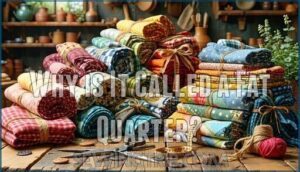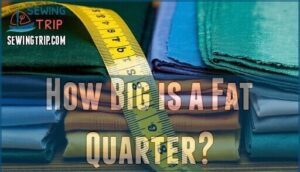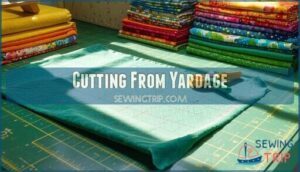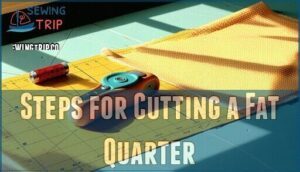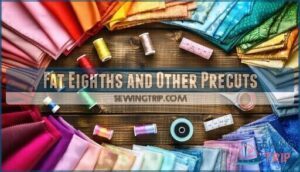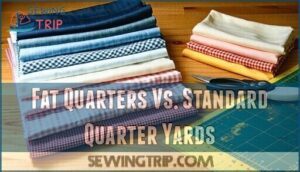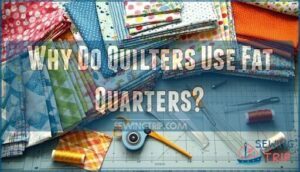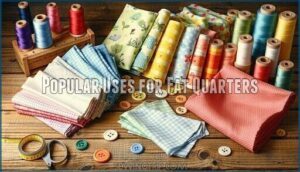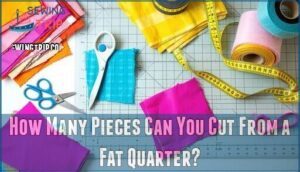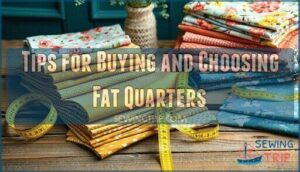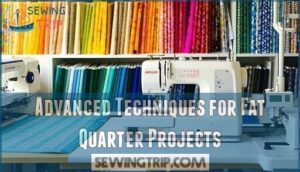This site is supported by our readers. We may earn a commission, at no cost to you, if you purchase through links.
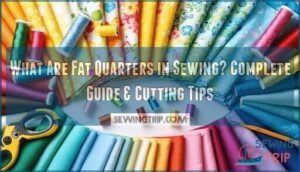
That extra width changes everything: you can cut more usable pieces, waste less fabric, and mix a dozen prints without your stash taking over your closet. Fat quarters let you build a diverse fabric collection without the guilt of buying yardage that sits untouched for years.
Table Of Contents
- Key Takeaways
- What is a Fat Quarter in Sewing?
- Why is It Called a Fat Quarter?
- How Big is a Fat Quarter?
- How is a Fat Quarter Cut?
- Fat Quarters Vs. Standard Quarter Yards
- Why Do Quilters Use Fat Quarters?
- Popular Uses for Fat Quarters
- How Many Pieces Can You Cut From a Fat Quarter?
- Tips for Buying and Choosing Fat Quarters
- Advanced Techniques for Fat Quarter Projects
- Frequently Asked Questions (FAQs)
- Conclusion
Key Takeaways
- Fat quarters (18×22 inches) give you a wider, more adaptable cut than standard quarter-yard strips (9×44 inches), letting you cut larger blocks and diverse shapes without fighting narrow fabric constraints or creating unusable waste.
- These precuts revolutionize fabric collection building by allowing you to mix dozens of prints affordably without committing to full yardage, making them essential for quilters who want design freedom and variety without budget strain or storage overwhelm.
- The squarer dimensions deliver superior fabric efficiency—you can cut 12-20 different pieces (depending on size) from a single fat quarter, making them ideal for patchwork, small projects like pouches and bags, and testing patterns before investing in full yards.
- Fat quarters emerged in the mid-1980s as a strategic response to quilters’ needs, borrowing terminology from the meat industry to describe this "fatter" cut that optimizes usable sewing area and has since become the standard precut in quilting shops worldwide.
What is a Fat Quarter in Sewing?
A fat quarter isn’t just another piece of fabric—it’s your ticket to creative freedom without committing to full yardage.
This precut gives you more design flexibility than standard quarter-yard cuts, and once you understand what makes it different, you’ll see why quilters and sewers reach for it first.
Let’s break down exactly what a fat quarter is, how it’s measured, and why that cut matters for your projects.
Fat Quarter Definition
A fat quarter is a precut piece of fabric measuring 18 by 22 inches—a quarter-yard of material that’s been cut differently to give you more usable width and less restrictive length. Think of it as your ticket to smarter fabric cutting, especially for quilting and crafting projects where you need adaptable pieces.
Here’s what makes fat quarters essential in your sewing arsenal:
- Pre-measured and ready to use—no wrestling with yardage or measuring tape
- Wider surface area lets you cut more diverse shapes and patterns
- Perfect size for mixing multiple prints without buying full yards
- Standard in quilting shops, making fabric shopping consistent and predictable
- Eliminates waste from awkward narrow strips
Typical Dimensions (Inches and Centimeters)
In the US, you’ll find fat quarters measuring 18 by 22 inches, while UK quilters work with slightly larger pieces at approximately 50 by 55 centimeters (roughly 20 by 22 inches).
These fabric dimensions can shift depending on the original fabric width—wider bolts give you more generous precut pieces. That’s why checking the actual size variations before you buy matters, especially when your pattern demands precise dimension standards for cutting success.
How Fat Quarters Are Cut
To get that perfect 18 by 22-inch rectangle, you’ll cut a half-yard piece of fabric (measuring 18 inches along the length) and then slice it in half widthwise down the middle. This cutting technique transforms a standard quarter-yard into a more adaptable precut size:
- Start with half a yard of fabric from the bolt
- Measure 18 inches along the fabric’s length
- Cut straight across the width at the halfway point
- You’ve now got two fat quarters with better fabric efficiency for your projects
Why is It Called a Fat Quarter?
The name "fat quarter" isn’t just quilter slang—it’s a direct rebellion against the standard quarter-yard cut. You’re getting the same amount of fabric, but sliced in a way that gives you more control over your designs.
The "fat" part tells you exactly what you’re buying: a wider, squatter piece that opens up creative possibilities you can’t get from a skinny strip.
Origin of The Term
You’ve probably wondered where the quirky term "fat quarter" came from—it’s not about weight or diet plans. This fabric history traces back to the mid-1980s quilting boom, when shops started marketing these squat, square-ish cuts to quilters hungry for variety. The "fat" references the shape: wider and more usable than skinny standard cuts. Curiously, the term borrowed from meat industry language, where "fat quarter" described a meat section with both lean and fat portions. Quilters adopted it metaphorically to describe their chunkier, more adaptable fabric pieces. By 1986, Country Needlework magazine was already explaining the term, cementing it in quilting vocabulary as textile evolution met crafting language innovation. Understanding fabric stash basics is essential for quilters to make the most of their materials.
| Aspect | Fat Quarter Origin | Standard Quarter |
|---|---|---|
| Era Emerged | Mid-1980s quilting culture | Traditional fabric measurement |
| Shape Reference | Squat, wider, "fatter" cut | Long, narrow strip |
| Industry Influence | Borrowed from meat terminology | Standard yardage division |
| Purpose | Optimize usable sewing area | Simple lengthwise measurement |
| Cultural Impact | Revolutionized quilt making bundles | Basic fabric purchasing unit |
Difference From Regular Quarter Cuts
Regular quarter cuts and fat quarters might share a name, but they’re built for completely different sewing missions. A standard quarter-yard measures 9 inches by the full fabric width (most often 44 inches), creating a long, skinny strip perfect for borders and binding.
Fat quarters flip that script: 18 x 22 inches of usable surface area that lets you cut wider blocks and intricate shapes without fighting narrow constraints. This cutting variation delivers excellent fabric efficiency for patchwork, giving you sewing flexibility that regular quarters can’t match.
Quilters prize these precut benefits—fat quarters release design possibilities that skinny strips simply strangle.
How Big is a Fat Quarter?
You’ll need to know the exact measurements to plan your projects and shop smart. Fat quarter sizes can shift slightly depending on where you’re buying and what fabric you’re working with.
Let’s break down the standard dimensions and what affects them.
Standard US and UK Sizes
In the US, you’ll find fat quarters measuring 18 inches by 22 inches—that’s your standard size cut from typical 44-45-inch fabric bolts. UK quilters work with slightly different measurements: 50 cm by 55 cm (roughly 19.7 by 21.7 inches).
These metric conversions matter when you’re sourcing fabric internationally or following patterns from different regions, so double-check those measurements before diving into your sewing projects. When working with fat quarters, understanding fat quarter dimensions is essential for successful sewing projects.
Variation by Fabric Width
Your fabric’s width isn’t set in stone—quilting cotton usually runs 42 to 45 inches wide, but you’ll encounter variations that directly affect your fat quarter’s final dimensions.
Here’s what changes your cutting game:
- Wider bolts (like 108-inch backing fabric) give you oversized fat quarters—perfect for larger blocks without piecing
- Metric fabrics from European suppliers often measure 110-150 cm wide, requiring yardage conversion adjustments before cutting
- Vintage or specialty weaves might shrink your usable area if the fabric width falls below standard measurements
Master fabric selection by checking the selvage-to-selvage measurement first—this controls your cutting adjustments and prevents pattern surprises.
Comparison to Quarter-Yard Cuts
Think of a regular quarter-yard cut as a tall, skinny strip—9 inches wide and stretching the full 42-44 inches of your fabric’s width—while a fat quarter flips those proportions into a compact 18×22-inch rectangle that opens up entirely different cutting possibilities.
That wider surface area means you’ll cut larger blocks without fabric waste, giving you serious sewing flexibility for quilting fabric projects.
Regular quarter yards work best for strip piecing and borders, but fat quarters dominate when you need cutting variations that optimize fabric efficiency and fabric measurement control.
How is a Fat Quarter Cut?
Cutting your own fat quarters isn’t complicated—you just need to know where to make the cuts. The process starts with a half-yard of fabric and involves one simple crosswise slice.
You can also create smaller precuts like fat eighths using the same straightforward method.
Cutting From Yardage
To get a fat quarter, you’ll start with a half-yard piece straight off the bolt—that’s your foundation. This yardage conversion gives you twice the width to work with compared to a standard quarter-yard strip.
Here’s what makes cutting from yardage smart:
- Fabric optimization starts with measuring your half-yard accurately—18 inches down the length
- Efficient measuring means folding that half-yard in half widthwise, selvage to selvage
- Cutting strategies focus on one clean slice through the fold for two equal rectangles
- Precut benefits include consistent 18×22-inch pieces ready for any quilting fabric project
- Fabric cutting techniques let you stack multiple half-yards to create several fat quarters at once
This fabric selection and cutting method gives you maximum control over your materials.
Steps for Cutting a Fat Quarter
Let’s break this down into foolproof steps that’ll have you cutting perfect fat quarters every single time. First, grab your rotary cutter and cutting mat—precision techniques matter here.
Lay your half-yard flat for fabric preparation, smoothing wrinkles. Fold it selvage to selvage, creating that 18-inch width. One decisive cut through the center gives you two fat quarters with zero waste minimization issues.
These fabric cutting techniques optimize fabric efficiency while keeping your quilting and sewing projects on track.
Fat Eighths and Other Precuts
Once you’ve mastered fat quarters, fat eighths, and other precuts, they open up a whole new level of fabric flexibility for smaller-scale projects. A fat eighth measures 9 x 22 inches—half a fat quarter—perfect for mini quilts and scrap management.
You’ll find fabric bundles with coordinating precut fabrics that simplify your quilting fabric choices, giving you design freedom without buying full yardage for every pattern you want to test.
Fat Quarters Vs. Standard Quarter Yards
Not all quarter yards are created equal. While a standard quarter yard gives you a long, narrow strip, a fat quarter flips the dimensions to offer a wider, more adaptable cut.
Understanding the difference helps you pick the right option for your project and make the most of every inch.
Shape and Usable Area
The shape difference between a fat quarter and a standard quarter-yard cut completely changes how much you can actually do with your fabric. A fat quarter gives you a squarer piece—18×22 inches—while a standard quarter yard is a long, narrow strip at 9×44 inches. That squarer shape means better fabric utilization when you’re cutting multiple pieces for quilting techniques or patchwork blocks.
| Measurement | Fat Quarter | Standard Quarter Yard |
|---|---|---|
| Dimensions | 18" × 22" | 9" × 44" |
| Total Area | 396 sq. inches | 396 sq. inches |
| Usable Space | Wide, square cuts | Long, narrow strips |
| Shape Variations | Adaptable for blocks | Limited to strips |
| Fabric Efficiency | High for varied sizes | Best for borders |
The fabric cutting and preparation process becomes more efficient with fat quarters because you’re not fighting that narrow strip. You can cut larger squares, rectangles, and triangles without constantly rotating your fabric or losing usable space to awkward angles.
Design Flexibility
With a squarer canvas, you’re no longer boxed into designing around that long, skinny strip—fat quarters let you plan patterns with way more creative freedom. You can mix prints, experiment with color schemes, and cut varied quilt block shapes without fighting fabric limitations. That’s the advancement: patchwork and appliqué projects suddenly open up.
| Design Element | Fat Quarter Advantage |
|---|---|
| Pattern Mixing | Multiple fabric options in one project |
| Quilt Block Cuts | Larger squares and flexible shapes |
| Color Schemes | Easier coordinating across quilting layouts |
| Creative Freedom | Adaptable to complex patchwork designs |
Best Uses for Each Cut
Standard quarter-yard cuts—those 9" x 44" strips—dominate when you’re tackling strip piecing, borders, or binding for quilting blocks. Their length matters for continuous sewing projects. Fat quarters, meanwhile, rule in patchwork designs and craft applications where fabric efficiency and width count. You’ll grab them for appliqué, cutting varied quilting blocks, or any sewing projects demanding squares and wider shapes. Pick your cut based on project needs, not habit.
| Cut Type | Best For | Why It Works |
|---|---|---|
| Standard Quarter Yard | Binding, borders, strip piecing | Long continuous strips optimize length |
| Standard Quarter Yard | Backing strips, sashing | Uninterrupted fabric runs simplify assembly |
| Fat Quarter | Patchwork blocks, appliqué | Width accommodates diverse quilting shapes |
| Fat Quarter | Small bags, pouches, accessories | Near-square dimensions reduce waste |
| Fat Quarter | Sampling prints, crafting with fabric | Showcases larger motifs and patterns |
Why Do Quilters Use Fat Quarters?
Fat quarters aren’t just popular—they’re a breakthrough for quilters who want more creative control without breaking the bank or dealing with wasted yardage.
Fat quarters give quilters creative control and fabric variety without the expense or waste of buying full yardage
You’ll find they solve three major problems that standard cuts can’t touch. Here’s why serious quilters keep fat quarters stocked in their studios.
Versatility in Patchwork
Fat quarters turn patchwork into a playground where you can mix, match, and experiment without committing to full yards of fabric—giving you the freedom to play with dozens of prints in a single project.
Their square-ish shape lets you cut various block patterns and color combinations without running out of width.
You can layer quilting techniques, try bold fabric mixing, and create intricate patchwork designs that would be impossible with narrow quarter-yard strips.
Waste Reduction
Because fat quarters give you that wider, squarer cut, you’re not left with awkward scraps or thin strips that are too small to use—every inch counts, and almost nothing ends up in the trash. This efficient cutting approach bolsters sustainable sewing and eco-friendly practices, letting you optimize your fabric selection and cutting strategy.
- Scrap quilting becomes a powerful way to use every fabric scrap instead of tossing leftovers
- Waste minimization keeps your quilting and sewing budget in check while protecting the planet
- Strategic cuts from fat quarters yield usable pieces without the frustration of narrow, unusable remnants
Access to More Prints and Patterns
When you purchase individual fat quarters or bundles, you gain access to dozens—sometimes over 40—distinct prints without committing to full yardage. Leading manufacturers like Moda and Robert Kaufman release complete seasonal collections as bundles, giving you instant print variety and pattern diversity across curated color schemes. That’s why over 60% of quilters prefer bundles for accessing new textile design options affordably.
| Bundle Feature | Print Access | Cost Advantage |
|---|---|---|
| Individual fat quarters | $2–4 per unique fabric | Buy only what you need |
| Coordinated bundles (10–40 prints) | Complete collection at once | 10–20% savings vs. yardage |
| Limited-edition collaborations | Exclusive patterns unavailable by the yard | Access trending designs early |
| Mix-and-match retailer discounts | Tailored fabric choices across collections | Further reduced barrier to variety |
This approach transforms your fabric scrap strategy—you’re building a diverse stash for quilting and patchwork projects while keeping costs low and creative fabric choices wide open.
Popular Uses for Fat Quarters
Fat quarters aren’t just for quilting—they’re workhorses for all kinds of creative projects. Whether you’re piecing together a quilt, adding custom touches to garments, or tackling smaller sewing ideas, these precuts deliver serious versatility.
Here’s how you can put them to work.
Quilting and Patchwork
If you’re piecing together a quilt, fat quarters are your secret weapon for building blocks that pop with personality and pattern. You’ll cut precise squares, triangles, and strips without fighting narrow fabric. Their shape gives you design freedom—mix prints, play with color coordination, and test bold patchwork patterns before committing to full yardage. Fat quarter quilting lets you master sewing techniques on a scale that feels manageable, not overwhelming.
- Fabric selection mastery: Build a diverse color palette without buying full yards of every print
- Efficient fabric cutting: The 18×22 dimensions let you slice multiple quilt blocks from one piece
- Instant quilt design variety: Swap fat quarters in and out to preview different patchwork patterns before stitching
Small Sewing Projects
Beyond quilts, you’ll find fat quarters are perfect for standalone projects that don’t demand yards of fabric—pouches, zippered bags, Kindle covers, and patchwork tote bags all fit comfortably within that 18×22 rectangle.
You’ll create home decor items like cushion covers or mini quilts, experiment with craft ideas using fabric scrap combinations, or assemble sewing kits for travel.
Fat quarters give you room to master fabric selection and cutting without wrestling full yardage, turning sewing projects into quick wins.
Appliqué and Decorative Techniques
When you want to layer shapes, add intricate motifs, or turn plain fabric into something eye-catching, appliqué and decorative techniques let you do it without wasting a single inch of your fat quarter.
You’ll cut precise appliqué designs, experiment with decorative stitches, and build quilting motifs that showcase textile artistry.
Fat quarters give you enough room for fabric embellishments and appliqué techniques that demand control over fabric selection and cutting—perfect for mastering each stitch.
Garment Accents and Accessories
You can take those same fat quarters and turn them into waistband facings, pocket linings, or bold accent pieces that make a garment uniquely yours.
Think zipper pouches, decorative sewing trims, or fabric embellishments that add punch to plain seams.
Fat quarters give you enough room for accessory making and garment linings without buying full yardage—ideal for quilting-inspired details on everyday wear.
How Many Pieces Can You Cut From a Fat Quarter?
When you cut into a fat quarter, you’re not just slicing fabric—you’re unlocking dozens of possibilities. The number of pieces you can get depends on what you’re making and how smart you’re with your cuts.
Here’s how to make every inch count.
Common Cuts for Quilting Blocks
Most quilters reach for their rotary cutters and slice fat quarters into squares, rectangles, or triangles—the building blocks that transform a single piece of fabric into dozens of patchwork designs. Common quilting patterns demand specific cuts:
- 5-inch squares – yields 12 pieces for charm quilt blocks
- 4-inch squares – produces 20 pieces for nine-patch designs
- 2.5-inch strips – creates 8 strips for strip piecing techniques
- Half-square triangles – cuts 18 from 5-inch squares for classic block patterns
Your fabric selection and cutting methods directly impact how many quilt blocks you’ll make from each fat quarter.
Cutting for Small Projects
Small projects like pouches, coasters, and zippered bags demand different cutting strategies than quilting blocks, so you’ll want to plan your cuts based on the finished dimensions plus seam allowances. A standard pouch needs two 10×8-inch rectangles, while coasters require four 5-inch squares.
Precision cutting tools and small project patterns help you optimize fabric scrap management—turning fat quarters into accessories without wasting an inch of your carefully selected quilting fabric.
Maximizing Fabric Efficiency
Every inch counts when you’re working with just 396 square inches, so learning to nest your cuts and minimize waste can stretch a single fat quarter into multiple coordinated projects.
Strategic fabric optimization means arranging pattern pieces like a puzzle—placing larger cuts first, then filling gaps with smaller shapes.
You’ll master efficiency tips through careful fabric selection and cutting, using quilting techniques that turn scraps into usable strips or bias tape rather than discarding them.
Tips for Buying and Choosing Fat Quarters
Buying fat quarters isn’t just about grabbing pretty fabric—it’s about making smart choices that set your project up for success. You need to know what to look for, how to spot quality, and when coordinating bundles actually save you time and money.
Here’s what separates confident fabric buyers from those who end up with unusable scraps.
Selecting Fabrics and Colors
Choosing the right fabrics and colors for your fat quarter collection can make or break your finished project—think of it as casting the perfect ensemble for a visual performance where every piece needs to play its part.
Start with these fabric selection fundamentals:
- Color theory guides your palette building—group warm or cool hues for cohesion
- Fabric texture adds dimension—mix solids with tone-on-tones
- Print mixing creates visual interest—vary scale from large to small motifs
- Hue selection sets your mood—bold contrasts energize, analogous colors soothe
Visit fabric stores with your quilting fabric goals in mind, and trust your eye for what works together.
Coordinating Bundles
Pre-matched fabric bundles take the guesswork out of color coordination, delivering designer-curated collections where every print already plays well with the others. These fat quarter bundles save you time on fabric pairing and pattern mixing, while bundle deals often cost less than buying individual cuts.
Look for themed collections that match your quilting fabric vision—whether that’s vintage florals or modern geometrics—and you’ll simplify your fabric crafting while expanding your creative possibilities.
Checking Measurements and Quality
Not all fat quarters measure exactly what the label promises, so grab your ruler and inspect the fabric before you commit—especially when buying online or from discount bins. Quality control matters for precision cutting and successful quilting fabric projects.
Check these essentials during fabric inspection:
- Verify dimensions against the advertised 18×22 inches, accounting for selvage inclusion
- Examine weave quality for consistent thread tension and minimal flaws
- Confirm print alignment to guarantee patterns run straight for accurate fabric cutting
These measurement tips protect your investment and guarantee your fat quarters deliver the usable area your project demands.
Advanced Techniques for Fat Quarter Projects
Once you’ve mastered the basics, it’s time to push your skills further and squeeze every bit of potential from your fat quarters.
Expert cutting and sewing techniques let you work faster, more precisely, and tackle projects that demand real craftsmanship.
Here’s how to level up your fat quarter game.
Stacking and Rotary Cutting
Stacking multiple fat quarters and using a rotary cutter turns what could be hours of tedious scissor work into a matter of minutes. You’ll align your fabric layers carefully, then slice through all of them at once with precision techniques that deliver clean edges every time. This layered cutting approach is a revolutionary step for quilting and sewing projects.
| Technique | Best For | Efficiency Gain |
|---|---|---|
| Single Layer | Curved cuts, appliqué | Standard baseline |
| 2-4 Layers | Mixed prints, controlled accuracy | 2-4x faster |
| 6-8 Layers | Uniform strips, squares | 6-8x faster |
| Rotary Tools | All fabric cutting needs | Maximum precision |
Template and Precision Cutting
Templates transform guesswork into repeatable accuracy, letting you trace shapes like hexagons, diamonds, and curves onto fat quarters with the confidence of a surgeon marking an incision line.
You’ll use acrylic templates or cardboard guides with your rotary cutter and cutting mat to maintain consistent seam allowances. These precision techniques guarantee every piece matches perfectly—no more wonky angles or misaligned patchwork blocks.
Fabric optimization reaches its peak when accurate measurements meet smart template making.
Making Bias Tape and Complex Patterns
Bias tape bends around curves and finishes edges where straight-grain fabric would buckle and fight you—and fat quarters give you just enough fabric to slice continuous strips on the diagonal without buying a full yard. You’ll cut bias tape widths from 1¼ to 2 inches for binding curved piecing or mitering corners on quilt patterns.
Pattern scaling demands fabric manipulation skills—fat quarters let you test complex quilting fabric arrangements before committing to larger yardage.
Frequently Asked Questions (FAQs)
How many fat quarters do I need for a baby quilt?
A standard baby quilt (around 36×52 inches) usually needs 12-20 fat quarters, depending on block dimensions and pattern complexity.
Simpler quilting patterns with larger blocks require fewer fat quarters, while intricate quilting designs increase fabric needs and potential waste.
What’s the difference between a charm pack and a fat quarter bundle?
Charm packs contain small squares—usually 5×5 inches—while fat quarter bundles include larger 18×22-inch pieces.
Charm packs work best for quick piecing projects, whereas fat quarters offer more design variety and fabric quantity for flexible cutting.
Are there any quick and easy fat quarter projects for beginners?
Beginners often feel overwhelmed, yet fat quarters make sewing projects for beginners remarkably simple.
Try fabric coasters, easy bags, or headbands tutorial for quick DIY crafts—perfect for quilting for beginners without complex patterns.
Can fat quarters be used for bias binding?
Yes, fat quarters work great for bias tape. Cutting on the bias at a 45-degree angle to the fabric grain lets you make continuous strips.
One fat quarter usually yields several feet of bias tape, perfect for seam finishing or binding small projects.
How do you store fat quarter collections?
You don’t need fancy systems to protect your fabric. Store fat quarters flat in clear plastic bins or rolled in drawer organizers—both methods prevent fading and creasing while keeping your collection visible and organized by color or project.
Whats the cost difference versus buying yardage?
Fat quarters usually cost more per yard than bulk yardage—often 20-40% higher—but they minimize fabric waste for small projects and let you sample multiple prints without hitting discount thresholds, making them ideal for variety-driven work.
Can you make a full quilt top?
Building a quilt top from fat quarters is like assembling a mosaic—you’ll need enough tiles to complete the picture.
With sufficient fat quarters and strategic block size planning, you can absolutely create a full quilt top, though fabric quantity and layout options depend on your quilt size and project complexity.
Are fat quarters good for beginner sewers?
Absolutely—fat quarters are perfect for beginners. They’re affordable, so you can experiment with fabric selection without breaking the bank.
Their size suits small sewing projects while offering enough variety to build quilting skills and explore different patterns confidently.
Conclusion
Here’s what separates serious sewers from fabric hoarders: knowing what fat quarters in sewing can actually do for your projects. You’ve learned the dimensions, the cutting methods, and the creative possibilities these precuts reveal.
Now you hold the blueprint for building a well-rounded fabric collection that doesn’t drain your budget or overwhelm your workspace. Stop second-guessing every yard of fabric you buy—grab a bundle, slice it smart, and stitch something that proves you’ve mastered the craft.
- https://www.awin1.com/cread.php?awinmid=6220&awinaffid=216447&platform=dl&ued=https%3A%2F%2Fwww.etsy.com%2Fsearch%3Fq%3DNotting%2520Hill%2520Fat%2520Quarter%2520Bundle
- https://crazylittleprojects.com/planners-printables-and-post-its/
- https://www.u-createcrafts.com/fabric-basket-tutorial-with-delia/
- http://mailto:info.uk
- https://www.thecreativecurator.com/dimensions-of-a-fat-quarter/

